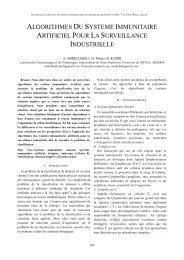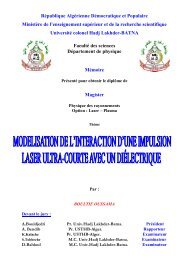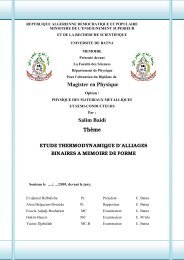Europe's Quest for the Universe - Laboratoires de Recherche
Europe's Quest for the Universe - Laboratoires de Recherche
Europe's Quest for the Universe - Laboratoires de Recherche
You also want an ePaper? Increase the reach of your titles
YUMPU automatically turns print PDFs into web optimized ePapers that Google loves.
40 Europe’s quest <strong>for</strong> <strong>the</strong> <strong>Universe</strong><br />
place <strong>the</strong>se at Calar Alto in Spain and on <strong>the</strong> Gamsberg in South West Africa<br />
(Namibia). Because of political problems with <strong>the</strong> latter site, <strong>the</strong> 3.5-m and<br />
one of <strong>the</strong> 2.2-m telescopes had been placed at Calar Alto, while <strong>the</strong> remaining<br />
2.2-m was stored awaiting better days. However, <strong>the</strong> political situation<br />
remained unchanged and having an expensive telescope lying about unused<br />
and ageing became an embarrassment. Hence an approach from <strong>the</strong> Presi<strong>de</strong>nt<br />
of <strong>the</strong> MPG to discuss <strong>the</strong> possibility of placing it at La Silla. Since <strong>the</strong> attitu<strong>de</strong>s<br />
of <strong>the</strong> MPIA and ESO at <strong>the</strong> time were ra<strong>the</strong>r different, it seemed clear<br />
that this could only work if ESO would gain full control of <strong>the</strong> telescope and<br />
its mo<strong>de</strong>rnization. After some difficult negotiations an agreement was reached<br />
un<strong>de</strong>r which ESO would receive <strong>the</strong> telescope on long term loan and have<br />
<strong>the</strong> exclusive responsibility <strong>for</strong> its upgrading and operation. In return <strong>the</strong><br />
MPIA would receive 25% of <strong>the</strong> observing time. This provi<strong>de</strong>d an excellent<br />
2.2-m telescope at La Silla, suitable <strong>for</strong> programs that did not require <strong>the</strong><br />
3.6-m, but <strong>for</strong> which <strong>the</strong> 1.5-m Danish was ina<strong>de</strong>quate. After <strong>the</strong> telescope<br />
began to function successfully <strong>the</strong> relationship with <strong>the</strong> MPIA became smooth<br />
and cordial.<br />
O<strong>the</strong>r European 4-m Class Telescope Projects<br />
In 1961 <strong>the</strong> UK had <strong>de</strong>finitely abandoned participation in ESO and<br />
<strong>de</strong>ci<strong>de</strong>d to have a joint project with Australia <strong>for</strong> a 3.9-m telescope. The<br />
telescope was to be as much as possible a copy of <strong>the</strong> Kitt Peak (Arizona)<br />
150-inch national US telescope. It was finally completed in 1974 and placed<br />
on <strong>the</strong> Siding Springs site near Coonabarabran (NSW) which belonged to <strong>the</strong><br />
Australian National University. While this site was free from <strong>the</strong> light<br />
pollution that had plagued <strong>the</strong> ANU observatory at Mt. Stromlo near<br />
Canberra, it was only mo<strong>de</strong>rately suitable because of its low altitu<strong>de</strong>.<br />
However, <strong>the</strong> excellent quality of <strong>the</strong> telescope, and especially of its computer<br />
control system, ma<strong>de</strong> up <strong>for</strong> this drawback, and it has been very productive.<br />
Now that <strong>the</strong> UK has joined ESO, it is expected that its participation in <strong>the</strong><br />
AAT will diminish.<br />
The UK – later joined by <strong>the</strong> Ne<strong>the</strong>rlands with 20% participation –<br />
also <strong>de</strong>veloped major facilities on La Palma in <strong>the</strong> Canary Islands, where it<br />
now operates 4.5-m and 2.5-m telescopes. The site is excellent <strong>for</strong> optical<br />
telescopes, but was consi<strong>de</strong>red not optimal <strong>for</strong> <strong>the</strong> infrared. So, a 3.8-m IR<br />
telescope was also built, <strong>the</strong> UKIRT, at 4200 m on Mauna Kea (Hawaii). It<br />
is now also part of <strong>the</strong> UK – NL cooperation. Due to <strong>the</strong> high altitu<strong>de</strong> atmospheric<br />
transmission is very favorable and excellent results were obtained even<br />
in <strong>the</strong> 300 µm window.<br />
Also <strong>the</strong> French were anxious to construct a national telescope. Site<br />
tests in France and sou<strong>the</strong>rn Spain gave unsatisfactory results. So <strong>the</strong>y joined<br />
(initially at 42.5%) <strong>the</strong> Canadians and <strong>the</strong> University of Hawaii in <strong>the</strong>






